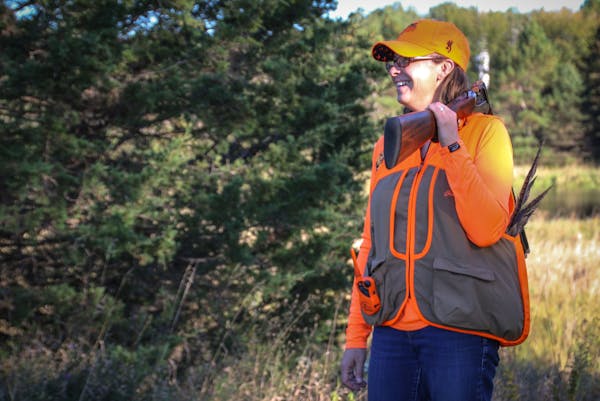When Friday morning rolls around, pheasant hunters from across the country will descend on the prairie towns of South Dakota, buying up game licenses at the incredible rate of one every 10 seconds.
That's the way it's been for years in the nation's top pheasant state, but conservationists, biologists and politicians remain worried about the future. The concern over fewer hens and roosters is decades old, but it's hot once again in the wake of this year's disappointing brood report — down 20 percent from a year ago.
State game managers say good pheasant opportunities will exist this year, and locals don't expect the cultural scene to change any time soon. But there's unmistakable long-term angst over dwindling pheasant populations caused by farming.
"Pheasant hunting and outfitting is a huge cultural and economic thing we can't let slip away,'' said John Cooper, former secretary of South Dakota Game Fish and Parks. "We need to do something.''
Cooper belongs to a large cohort of wildlife habitat leaders in the Upper Midwest who are pre-staging a rally to make changes in the U.S. Farm Bill. They want to reclaim at least some of the grasslands lost to agriculture. The circle includes Minnesota DNR Commissioner Tom Landwehr and his agency's fish and wildlife director, Jim Leach. Both men have been stressing the importance of land conservation in the next Farm Bill, due in 2018. The benefits would extend beyond pheasants to water cleanup, pollinator revival and other ground-nesting birds, Landwehr and Leach have said.
Shrinking grassland
Cooper said the crux of the problem in South Dakota has been the loss of 1.8 million acres of grassy habitat between 2006 and 2012. That's when farmers were plowing up pastures as well as lands idled by the Conservation Reserve Program (CRP) to cash in on soaring grain prices.
CRP had successfully boosted pheasant habitat by paying rent to farmers who took marginal land out of production to plant environment-friendly grasses and other plant species critical to ringnecks. From 1995 to 2005, CRP acreage crested and South Dakota's pheasant numbers soared from 4.9 million to 9.2 million. A couple of good years followed, including 11.9 million pheasants estimated in 2007. Lately the state's pheasant population has hovered between 6.2 million and 7.7 million birds.
Yet Congress, when debating the last Farm Bill, listened to agri-business, limiting CRP and adopting production-oriented subsidies. Grass regimes, Cooper said, weren't putting money into the pockets of fertilizer companies, chemical manufacturers and the implement industry.
Travis Runia, senior upland game biologist for South Dakota Game Fish and Parks, has said the decline of CRP acreage is continuing and raising the cap on the program is critical. South Dakota is left with 950,000 CRP acres, he said, a sum that is expected to shrink to 800,000 by the time the Farm Bill is debated some 18 months from now.
"If this trend continues we're going to see CRP acreage decline … which is extremely alarming and very much concerning for the future of pheasants in South Dakota,'' Runia said.
Tables turning
Cooper said South Dakota has nongovernment conservation partners and financial resources of its own to start reclaiming lost grassland. Private landowners were largely deaf to habitat deals when corn was selling for $7 a bushel, he said. Now, with market prices around $3 a bushel, some farmers' input costs — including debt incurred during the boom — will exceed revenues.
"A lot of people are saying, 'Geez, we have opportunities now' '' to make deals, Cooper said. The pitch to landowners will be for them to farm the best land and leave the rest for pheasant habitat, he said. The programs will vary, and managers will put more science behind the type of habitat that gets planted.
"Can we come back in South Dakota and reclaim 1.8 million acres?'' Cooper said. "No, but I believe we could get back 1 million acres if Congress cooperates. … CRP has to be the centerpiece.''
Keep truckin'
South Dakota's 2016 brood survey results indicate this year's decrease in birds is significant for the Chamberlain, Winner, Aberdeen, Huron, Mitchell, Yankton and Sioux Falls areas. Statewide, the pheasant-per-mile index is 3.05, down from 3.83 in 2015. That's likely to equate to an average harvest smaller than last year's 8.4 roosters per hunter.
But Cory Appl, manager of Ken's SuperFair Foods and Shell Express in Aberdeen, said local residents aren't concerned. Nonresidents account for well over 50 percent of pheasant hunters in the state, and the visitors aren't about to cancel their trips.
"The broods have been down, but we still get traffic,'' Appl said. "The big groups of hunters are still coming. It's a party for them, a vacation.''
Last year, of the 85,000 pheasant hunters who visited South Dakota, 22,000 were from Minnesota.
"It's a small window of economic opportunity, but absolutely it's huge,'' Appl said. "The towns go out of their way to accommodate this.''
Tony Kennedy • 612-673-4213
